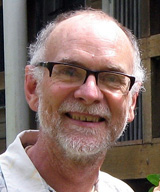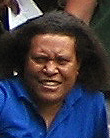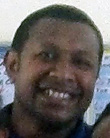full article:
Introduction
The United Nations Human Development Index places Papua New Guinea 158th out of 188 countries1. Recent World Bank data show that 49.5% of children aged less than 5 years in Papua New Guinea suffer from stunting due to poor nutrition and recurrent infection as a result of poor hygiene, water and sanitation2. Every year, around 5000-6000 neonates die out of a total of approximately 200 000 births, mainly from 'prematurity and low birth weight (35%), birth asphyxia (34%) and neonatal infections (32%). These children continue to die due to a lack of feasible, cost-effective care'3. In 2011, two cases of neonatal tetanus were reported inside Port Moresby General Hospital, the nation's major hospital3. Howes et al. document an overall decline in provision of health services in Papua New Guinea over the period 2002-20124. A study at Goroka Provincial Hospital found the commonest causes of death in children aged less than 5 years are 'disease states, microbial pathogens, adverse social circumstances and health service failures'5.
Simultaneously, Transparency International places Papua New Guinea 139th out of 167 countries on its Corruption Perceptions Index6. Papua New Guinea's systems of governance are complex, overlapping and multi-layered. Members of Parliament directly receive funds for disbursement to their electorates. In 2014, members representing 111 electoral districts nationally directly received PGK1.6 billion (A$670 million) in funds7. These funds are in addition to PGK1.8 billion (A$756 million) made available annually in the national budget for national and provincial departments of health8. Yet, it remains that in Eastern Highlands Province, health facilities 'need to have [they lack] available and functioning water supply' for staff to wash hands9.
In these circumstances, the present study examines the methodology and effect of one local organisation, Touching The Untouchables (TTU), providing community level training in primary health. The name alludes to the fact that existing services have left the rural districts completely untouched. TTU operates in Henganofi District, one of the eight districts of Eastern Highlands Province (Fig1). The district has four health facilities with a total of 40 staff serving a population of about 76 000.
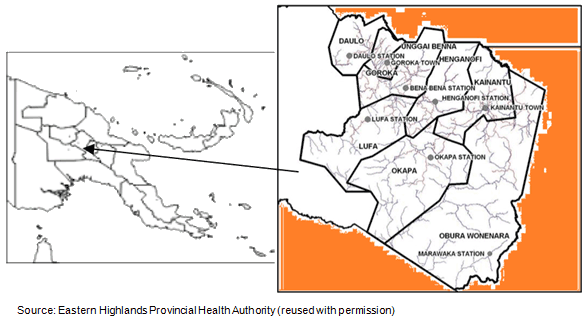
Figure 1: Eastern Highlands Province, Papua New Guinea, showing the location of Henganofi District.
Touching The Untouchables
TTU aims to support community self-reliance in health and disease prevention through a network of trained volunteers working in their own communities to implement the 10 Healthy Home and Village Criteria (Table 1), and supporting women safely into motherhood. Also in support of its training outcomes, TTU has a further role liaising between communities, health centres, government and overseas non-government organisation (NGO) providers to facilitate delivery of water supply and sanitation hardware and support mothers to have supervised deliveries.
Due to the lack of adequate health services, self-reliance is one of the few strategies available for Papua New Guinea's rural people, who represent 86% of the population, to improve their health. Self-reliance means using local resources of materials, people and knowledge with the aim of improving the local quality of life.
Village populations face a practical challenge to organise themselves to improve their quality of life when the daily demands on families are so great. For organisations promoting self-reliance, the message that 'you must do it yourselves' is not what overburdened communities want to hear. While their children's health is vital to every parent, village communities collectively struggle to accommodate another demand for a voluntary contribution.
As well as the practical demands of village life, a mindset referred to as 'cargo thinking' has been identified as a barrier to community development in Papua New Guinea. Cargo thinking is variously identified with post-colonial patron-client relationships10, father-child relationships11 and magical thinking12. Cargo thinking involves perceptions of power and dependence, leading to a loss of effective local problem-solving and initiative. The Bismarck Ramu Group, a leading Indigenous NGO based in Madang Province, sees the 'cargo mentality' as the antithesis of self-reliance, identifying it with a failure of 'people and communities to believe in themselves and their abilities'13.
Thus, the goal of improved environmental health cannot be only about lack of materials (polytanks, pipes, moulds, cement) or a lack of skills in delivery and neonatal care. The underlying issues of changing power relationships through collective organisation, leadership and community motivation must be addressed for people to take self-reliant action. TTU addresses this in two ways: through the content and methodology of its training programs, and through providing continued contact and support for the volunteer network that it has created as a result of that training.
Table 1: The 10 Healthy Home and Village Criteria
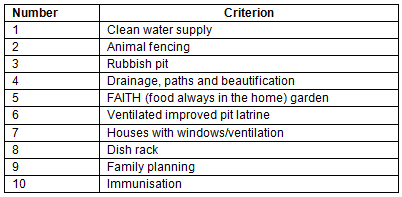
Training
Empowerment is oriented towards individual people taking collective action to improve their circumstances by rectifying disparities in social power and control. Thus, empowerment is operational on three levels: individual, group and society14. Training for empowerment therefore needs to give attention to the individual, organisational and social dimensions of life. In Papua New Guinea, failure of government, village communities that are collectively overburdened and cargo thinking combine to require empowerment as the strategy to produce community change.
TTU operates two streams of training: community health promoters (CHPs), who are male, and village birth attendants (VBAs), who are female. Both streams begin with a common curriculum titled 'Gender and leadership', which provides trainees with an introduction to inclusive community organising, teaching methods and basic health and hygiene.
In addition to participatory training in the teaching techniques used in the manuals, the course has units on gender, leadership, health and decision making15. TTU's introductory training theme of 'Gender and leadership' suggest there is an understanding of the importance of empowerment to achieving health outcomes. An examination of the methodology and content of this training gives a further indication of how the training seeks to empower participants.
Method
TTU training methodology addresses all three levels of empowerment (individual, community and social). It includes an individual or psychological dimension in the frequent use of role-plays and games. Individuals are required to act out conflict in their communities and to discuss and analyse how such conflict arises and can be resolved. Existing gender relations are challenged through requiring the equal participation of women as leaders and problem solvers in game scenarios. Culturally, this can be difficult for both men and women to accept. There is a collective orientation in problem solving and decision making, for example in participants collectively having to establish the rules for attendance and participation at the beginning of the training. Finally, there is a social dimension of citizen engagement through using videos about wider social and global issues in development as the vehicle to contextualise discussion about the physical and social changes that are occurring in Papua New Guinea's regions.
This methodology can be characterised as creating a variety of settings that require the use of the three types of communication needed for a group to undertake effective cooperative action for social change. These types of communication are:
- dramaturgical: like a drama performance. It is the way each of us presents ourselves to the world - our personal drama that we put on show for others. In dramaturgical communication we gradually open ourselves up to others to gain trust, understanding and acceptance
- normative: communication about what is normal and OK, for example acceptance of the equal place of women; our behaviour in a group needs to meet the approval of our peers
- teleological: the kind of communication you have at a meeting to make a decision; planning and decision making based on analysis of known facts16.
Since empowerment is defined as requiring this cooperative action, practise in appropriate settings of these three types of communication is an essential requirement to achieve that outcome.
Content
In addition to a methodology that encourages a variety of communication types, empowering training requires that participants collectively re-create knowledge about their circumstances. Specifically in the post-colonial context of Papua New Guinea, empowerment must emphasise breaking down the structures and practices of colonisation and domination of knowledge production by elites17,18. This process can be advanced by drawing on a variety of forms of knowledge.
An analysis of TTU training material shows that it employs four types of knowledge:
- knowledge based on evidence: germs, health and hygiene; nutrition
- knowledge that is reflexive: seeing and knowing ourselves in a mirror; history; identity; self-awareness
- knowledge of the broader Pacific and global context: seeing our place from outside; getting new perspectives and purpose
- knowledge of skills and techniques: teaching and practical.
Creating knowledge that is reflexive and exploring knowledge about the broader context uses special kinds of communicative tools that facilitate discussion on history, society and political economy. Several of the tools adopted by TTU have a documented 30-year history of effective use in the Pacific, including the Question Man, shown in Figure 2. Others are more recently developed in Papua New Guinea, but are also used Pacific-wide. The approach is firmly rooted in the work of Paulo Freire17 and the 'basic human need' school of development theorists from the 1970s. This approach was first adapted for the Pacific by Dr John Roughan and the Solomon Islands Development Trust during the 1980s18. Sections of the curriculum were adapted for use in Eastern Highlands Province based on the Lifewind International training manuals on community health evangelism19. All of life in Papua New Guinea has a spiritual dimension, as demonstrated in the widespread belief in sorcery20. As a consequence, it is appropriate that TTU training also has a basis in Christian faith. In post-training evaluations, trainees report that this is an important factor in successfully implementing the program in their communities.
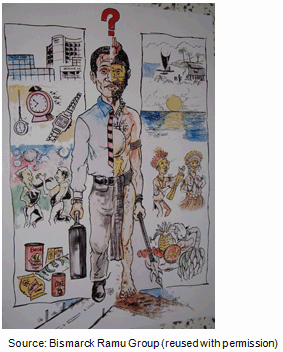
Figure 2: Question Man, an example of a tool used in the Pacific to generate discussion in empowering training practice.
Outreach
Following training, TTU maintains continuous contact with practising CHPs, VBAs and their communities through a monitoring program. Monitoring visits by TTU staff and trainers to all villages provide opportunities for data collection, assessment and on-site support for CHPs and VBAs.
TTU also provides liaison between communities and agencies that provide material support and additional training. In 2014, for the Community Health Promoter program, this included material support from Oxfam's Water, Sanitation and Hygiene program and Appropriate Technology Projects for toilet slabs and small-scale water supplies. TTU supports community organisation to facilitate collection of the 10% financial contribution required by the aid donor, labour to make toilet slabs and install water systems, and collection of materials such as sand, gravel and stone. For the VBA program, TTU liaison resulted in additional training support from Marie Stopes International, Mercy Works and Eastern Highlands Provincial Health Authority.
In addition to village visits, trained CHPs and VBAs are brought together for a one-day session at least once each quarter. The quarterly meeting builds solidarity among the volunteers. Contact is via an invitational letter that is (necessarily) hand delivered. These gatherings provide a regular opportunity for CHPs and VBAs to provide feedback and exchange information with TTU staff.
Both monitoring and quarterly meetings appear to be essential to keeping the volunteers motivated and informed, to receive feedback and resolve issues as they arise in their communities. Where budgets allow, small incentives are provided, such as gumboots, a torch or a small payment for attending a meeting. These approaches to supporting volunteer health workers share these characteristics with many similar programs globally21.
Effects of Touching The Untouchables
Since 2012, TTU has trained a total of 178 CHPs and 74 VBAs identifying with 107 different communities. With a dropout rate of around 50% over 4 years, TTU continues to have an active presence or a CHP, a VBA or both in 74 communities in Henganofi District. The intended effect of TTU is to improve district health statistics by increasing the number of deliveries with a trained person present and by improving village level environmental health through communities implementing the 10 Healthy Home and Village Criteria (Table 1)15. As a result of the TTU's liaison role, it would also be expected that some participating communities would have the benefit of water supply and sanitation hardware.
In regard to district health statistics, the Henganofi District key indicators report by year 2010-2015 shows that maternal and child health was either static or worsened22. The year 2014 was an exceptional year, including a severe outbreak of measles. These figures need to be seen in the light of the study by Howes et al4, which showed an overall decline in the availability of basic medicines, staff attendance and doctor visits. For supervised deliveries, the Henganofi District key indicators report shows that only one in five births occur in a health facility. Monitoring data from TTU show a small (7.3%) but increasing contribution by VBAs (Table 2). It can be assumed that prior to the VBA program there was no trained person supporting birthing mothers in the village. Anecdotally, it is reported that mothers commonly give birth in the family coffee plantation or at a nearby water source, not in the home.
For the 10 Healthy Home and Village Criteria, TTU monitoring data for 2013-2015 appear to be compromised in two ways. Some villages have not been revisited. This appears as no change in the averaged score per community across all 10 criteria. In other cases, the data collection method was not consistent from one visit to the next. This is evident from narrative reporting that contradicts the numerical data. Taking these factors into consideration, the data show an increase in the average score per community for all 10 criteria from 44% coverage to 57% across the whole district. Seven communities out of 30 that were 'target sites' achieved 100% averaged score and were designated model 'health promoting villages'. Achieving this benchmark also means that these seven communities were incentivised with water and sanitation hardware as part of their achievement23.
Table 2: Births in Henganofi District, Papua New Guinea, showing the limited use of health centres and the contribution of the village birth attendant program

Conclusions
The training approach of TTU reflects the way in which empowerment necessarily operates at personal, group and social levels in order to work towards the outcome of self-reliance. It includes an individual, psychological dimension in the use of role-plays and games, a collective orientation in problem solving and decision making, and a social dimension of citizen engagement. Underlying this training are definable types of knowledge and communication. TTU monitoring data show that communities have, to varying degrees, taken the initiative to implement the 10 Healthy Home and Village Criteria in a self-reliant fashion as a result of the CHP and VBA programs. As it is fundamental to the training, this implies that these communities have accepted change in gender relations, renewal of leadership, and have re-instituted effective processes of collective problem solving and decision making.
Acknowledgements
This article was produced as part of a project funded by Bread for the World, Pacific, and conducted by the Community Development Agency, Kundiawa. The authors thank Ursel Kroog and Yanny Guman for their support.
References
1. United Nations Development Program. Key to HDI countries and ranks, 2014. (Internet) 2014. Available: http://hdr.undp.org/sites/default/files/ranking.pdf Accessed 11 October 2016).
2. World Bank. Prevalence of stunting, height for age (% of children under 5). (Internet) 2016. Available: http://data.worldbank.org/indicator/SH.STA.STNT.ZS (Accessed 11 October 2016)
3. Government of Papua New Guinea. Newborn management policy, PNG National Health Plan 2011-2020. Port Moresby: National Department of Health, 2012.
4. Howes S, Mako AA, Swan A, Walton G, Webster T, Wiltshire C. A lost decade? Service delivery and reforms in Papua New Guinea 2002-2012. PNG Promoting Effective Public Expenditure Project. Canberra: The National Research Institute and Development Policy Centre, Australian National University, 2014.
5. Duke T, Michael A, Mgone J, Frank D, Wal T, Sehuko R. Etiology of child mortality in Goroka PNG: a prospective two-year study. Bulletin of the World Health Organisation 2002; 80(1): 16.
6. Transparency International. Table of results: Corruption Perceptions Index 2015. (Internet) 2016. Available: http://www.transparency.org/cpi2015#results-table (Accessed 11 October 2016).
7. Howes S, Fox R. How did PNG spend the resources boom? (Internet) 2016. Available http://devpolicy.org/how-did-png-spend-the-resources-boom-20160912/ (Accessed 9 October 2016).
8. Government of Papua New Guinea. Department of Treasury national budget. (Internet) 2015. Available: http://www.treasury.gov.pg/html/national_budget/files/2015/Vol1-Economic%20and%20Development%20Policies.pdf (Accessed 11 October 2016).
9. Eastern Highlands Province. Statistical analysis of outpatients in Henganofi District. Goroka: Eastern Highlands Province Health Authority, 2013.
10. Cox J. Active citizenship or passive clientelism? Accountability and development in Solomon Islands. Development in Practice 2009; 19(8): 966. http://dx.doi.org/10.1080/09614520903220784
11. West P. Environmental non governmental organisations and the nature of ethonographic enquiry. Social Analysis 2001; 45(2): 63.
12. Stanner WEH. On the interpretation of cargo cults. Oceania 1958; 29: 1-25. http://dx.doi.org/10.1002/j.1834-4461.1958.tb02934.x
13. Bismarck Ramu Group. BRG Vision: a fair and equitable society throughout PNG. Madang: Bismarck Ramu Group, 2014.
14. Zimmerman M. Empowerment theory: psychological, organisational, and community levels of analysis. In J Rappaport, E Seidman (Eds). Handbook of community psychology. New York: Plenum Publishers, 2000. http://dx.doi.org/10.1007/978-1-4615-4193-6_2
15. Touching The Untouchables. Gender and leadership participant training manual. Goroka: TTU, 2014.
16. Habermas J. Theory of communicative action: reason and the rationalization of society. Cambridge: Polity Press, 1984.
17. Freire P. Pedagogy of the oppressed. London: Penguin, 1970.
18. Barcham R. Theorising empowerment practice from the Pacific and Indigenous Australia. PhD thesis, Australian National University. (Internet) 2012. Available: https://digitalcollections.anu.edu.au/handle/1885/10317 (Accessed 14 March 2015).
19. Lifewind International. Mission directory. (Internet) 2016. Available: http://www.cmf.org.uk/international/hsp.asp?o=587 (Accessed 4 March 2015).
20. Andrew EVH, Pell C, Angwin A, Auwun A, Daniels J, Mueller I, et al. Factors affecting attendance at and timing of formal antenatal care: results from a qualitative study in Madang, Papua New Guinea. PLoS ONE 2014; 9(5): e93025. http://dx.doi.org/10.1371/journal.pone.0093025
21. USAID Health Care Improvement Project. Community health worker programs: a review of recent literature. (Internet) 2010. Available: http://chwcentral.org/sites/default/files/Community%20Health%20Worker%20Programs-%20A%20Review%20of%20Recent%20Literature_0.pdf (Accessed 8 October 2016).
22. Henganofi District Health Authority. Henganofi District - key indicators report by year 2010-2015. Heganofi: Henganofi District Health Office, 2015.
23. Touching The Untouchables. Monitoring data 2013-2015. Goroka: TTU, 2015.
